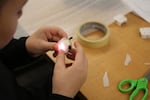
A Tumalo Community school student prepares a light he programmed to go into a student-designed product.
Emily Cureton/OPB
As the teacher explained how to program electronics with a tablet, 11-year-old Mieka Myers yawned.
But then, her computer science class took a sharp turn, from teaching kids how to use technology, to telling them a story about a person who needed a new product.
Mieka lit up.
“Yay! We get to to do something creative!” she squealed, as she was introduced to Shawna, an imaginary performance artist living 80 years from now.
“OK, so we need like a building with light, a lot of light, and a lot of shadows,” Meika said. “We need to build a shadow puppet theater.”
Suddenly, the earlier lesson in how to program an LED light took on significance and urgency. Mieka got to work with her group of three other 6th grade students from Tumalo Community School.
They were among 60 Central Oregon students who packed a lecture hall at Oregon State University Cascades to learn the basics of design. The objective was to create something innovative. Their first step? Empathize with someone in need of a new product.
“The idea is how do we move them from consumers to producers?” said Jill Hubbard, president of the Oregon Computer Science Teachers Association and a professor at OSU Cascades.
“The bigger picture of these kinds of activities is how do we prepare all students to move from a school environment, where it was all about gaining information, to now it’s about applying information and being innovative and creative," Hubbard said.
She added it's also about workforce. That's why field trips like this Middle School Computer Science Extravaganza are part of a statewide effort to create computer science curriculum in Oregon. The partners want to engage more kids in technology innovation when they are younger, funded by nearly $1 million from the National Science Foundation.
